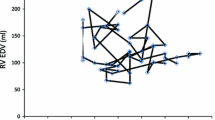Abstract
Continuous negative extrathoracic pressure (CNEP) has been recently reintroduced as therapy for respiratory failure. To determine its effects on cardiac output a pilot study was performed in ten patients aged 2 months-3 years (meadian 4 months). All had chronic respiratory failure (seven with bronchopulmonary dysplasia). Five were breathing spontaneously and five were intubated and undergoing intermittent positive pressure ventilation. Transcutaneous oxygen saturation andPCO2, together with ECG were continuously monitored. Pulmonary artery blood flow velocity was measured noninvasively using pulsed wave Doppler. The 95% confidence intervals for the changes with and without CNEP in spontaneously breathing and ventilated patients showed no statistically significant changes in heart rate, O2 saturation, transcutaneousPCO2 or cardiac output. This study shows that the use of CNEP, administered in a tank respirator, does not lead to large changes in cardiac output.
Similar content being viewed by others
Abbreviations
- CNEP:
-
continuous negative extrathoracic pressure
- CO:
-
cardiac output
- IPPV:
-
intermittent positive pressure ventilation
- PEEP:
-
positive end expiratory pressure
- PIP:
-
peak inspiratory pressure
- PVR:
-
pulmonary vascular resistance
References
Alverson DC, Eldridge M, Dillon T, Yabek SM, Berman W (1982) Noninvasive pulsed doppler determination of cardiac output in neonates and children. J Pediatr 101:46–50
Cournard A, Motley HL, Werko L, Richards DL (1948) Physiological studies on the effect of intermittent positive pressure breathing on cardiac output in man. Am J Physiol 52:162–174
Kanarek DJ, Shanon DC (1975) Adverse effects of positive end expiratory pressure on pulmonary perfusion and arterial oxygenation. Am Rev Respir Dis 112:457–459
Kumar A, Falke KJ, Geffin B, Aldredge CF, Laver MB, Lowenstein E, et al (1970) Continuous positive pressure ventilation in acute respiratory failure. N Engl J Med 283:1430–1436
Raine J, Wright TAM, Samuels MP, Southall DP, Modi N, Harvey D, Spencer A, Brookfield DSK (1991) The use of continuous extrathoracic pressure in neonatal respiratory failure: In: Lafeber HN (ed) Fetal and neonatal physiological measurements. Elsevier, Amsterdam, pp 265–270
Roos, A, Thomas LJ, Nagel EL, Prommas DC (1961) Pulmonary vascular resistance as determined by lung inflation and vascular pressures. J Appl Physiol. 16:77–84
Samuels MP, Southall DP (1989) Negative extrathoracic pressure in the treatment of respiratory failure in infants and young children. BMJ 299:1253–1257
Walther FJ, Siassi B, Ramadan NA, Ananda AK, Wu PYK (1985) Pulsed Doppler determinations of cardiac output in neonates: normal standards for clinical use. Pediatrics 76:829–833
Author information
Authors and Affiliations
Rights and permissions
About this article
Cite this article
Raine, J., Redington, A.N., Benatar, A. et al. Continuous negative extrathoracic pressure and cardiac output —a pilot study. Eur J Pediatr 152, 595–598 (1993). https://doi.org/10.1007/BF01954088
Received:
Accepted:
Issue Date:
DOI: https://doi.org/10.1007/BF01954088




